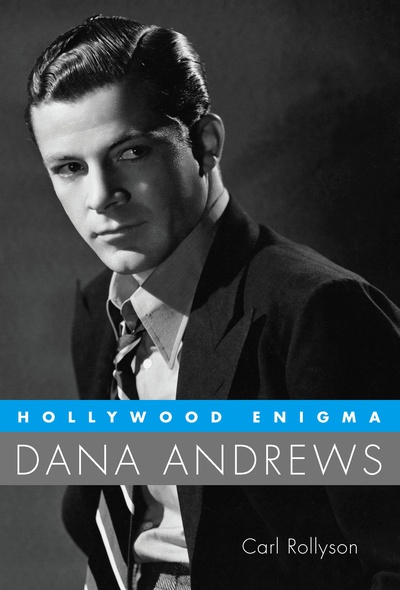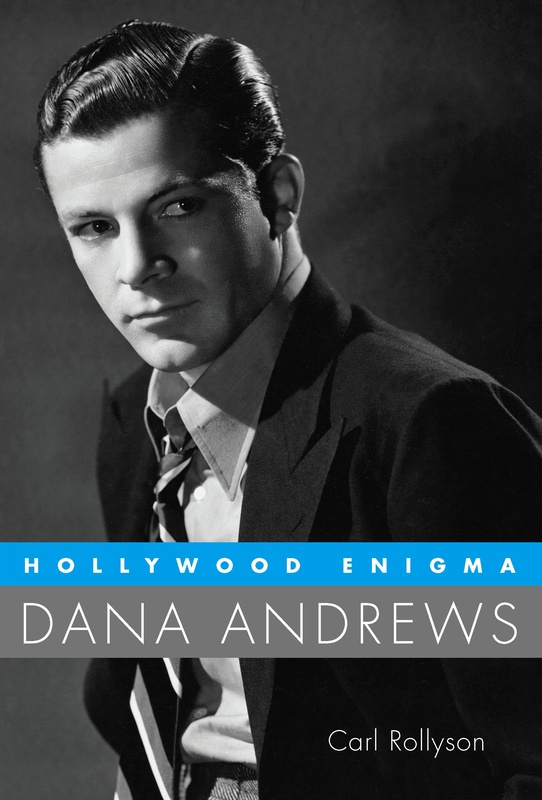
Dana Andrews (1909–1992) worked with distinguished directors such as John Ford, Lewis Milestone, Otto Preminger, Fritz Lang, William Wyler, William A. Wellman, Mervyn Le Roy, Jean Renoir, and Elia Kazan. He played romantic leads alongside the great beauties of the modern screen, including Joan Crawford, Elizabeth Taylor, Greer Garson, Merle Oberon, Linda Darnell, Susan Hayward, Maureen O’Hara, and most important of all, Gene Tierney, with whom he did five films. Retrospectives of his work often elicit high praise for an underrated actor, a master of the minimalist style. His image personified the “male mask” of the 1940s in classic films such as Laura, Fallen Angel, and Where the Sidewalk Ends, in which he played the “masculine ideal of steely impassivity.” No comprehensive discussion of film noir can neglect his performances. He was an “actor’s actor.”
Here at last is the complete story of a great actor, his difficult struggle to overcome alcoholism while enjoying the accolades of his contemporaries, a successful term as president of the Screen Actors Guild, and the love of family and friends that never deserted him. Based on diaries, letters, home movies, and other documents, this biography explores the mystery of a poor boy from Texas who made his Hollywood dream come true even as he sought a life apart from the limelight and the backbiting of contemporaries jockeying for prizes and prestige. Called “one of nature’s noblemen” by his fellow actor Norman Lloyd, Dana Andrews emerges from Hollywood Enigma as an admirable American success story, fighting his inner demons and ultimately winning.
Hollywood Enigma teaches us to appreciate an actor whose standing in the Hollywood pantheon should clearly be reassessed. As Mr. Rollyson clearly understands, Dana Andrews has nowhere to go but up.
Nothing else written about Andrews over the years pulls together so many sources of information so skillfully, making this likely the definitive biography of the man for all time.
The life of actor Dana Andrews (1909–1992)—a brilliant, woefully underrated Hollywood star—is at last given major treatment in this meticulous, haunting biography. Carl Rollyson has had unrestricted access to the Andrews family; to journals, letters, and private archives; to exclusive interviews; and to studio records. The result is the landmark chronicle of a highly gifted, deeply tortured but enormously likable man. Rollyson never flinches: the years of Andrews’s struggle with alcoholism and of professional decline are detailed here—but so are the many admirable achievements and the heroic triumph over addiction, mostly because of his faithful devotion to his wife and children. With countless others, I have always admired Dana Andrews; now, Carl Rollyson has shown, in this scholarly and immensely readable book, why our admiration is not misplaced.
Always understated and all too underrated, Dana Andrews now has a definitive biography of his own.
From the gritty small towns of olden Texas to California in the Great Depression to the movie factories of World War II, Hollywood Enigma chronicles the extraordinary struggle of an unlikely dreamer and reveals a unique side of one actor’s journey. The fierce ambitions of Carver Dana Andrews, son of a Baptist preacher, might well have been imagined by Horatio Alger, Jr.—or Samuel Goldwyn—but not the hidden costs behind those achievements. Carl Rollyson compassionately captures the man behind the movie star.
Carl Rollyson is professor emeritus of journalism at Baruch College, CUNY. He is author of many biographies, including Sylvia Plath Day by Day, Volumes 1 & 2; William Faulkner Day by Day; The Last Days of Sylvia Plath; A Real American Character: The Life of Walter Brennan; and Marilyn Monroe: A Life of the Actress, Revised and Updated. He is also coauthor (with Lisa Paddock) of Susan Sontag: The Making of an Icon, Revised and Updated. His reviews of biographies have appeared in the Wall Street Journal, Washington Post, and New Criterion. He also writes a column on biography twice a week for the New York Sun.





